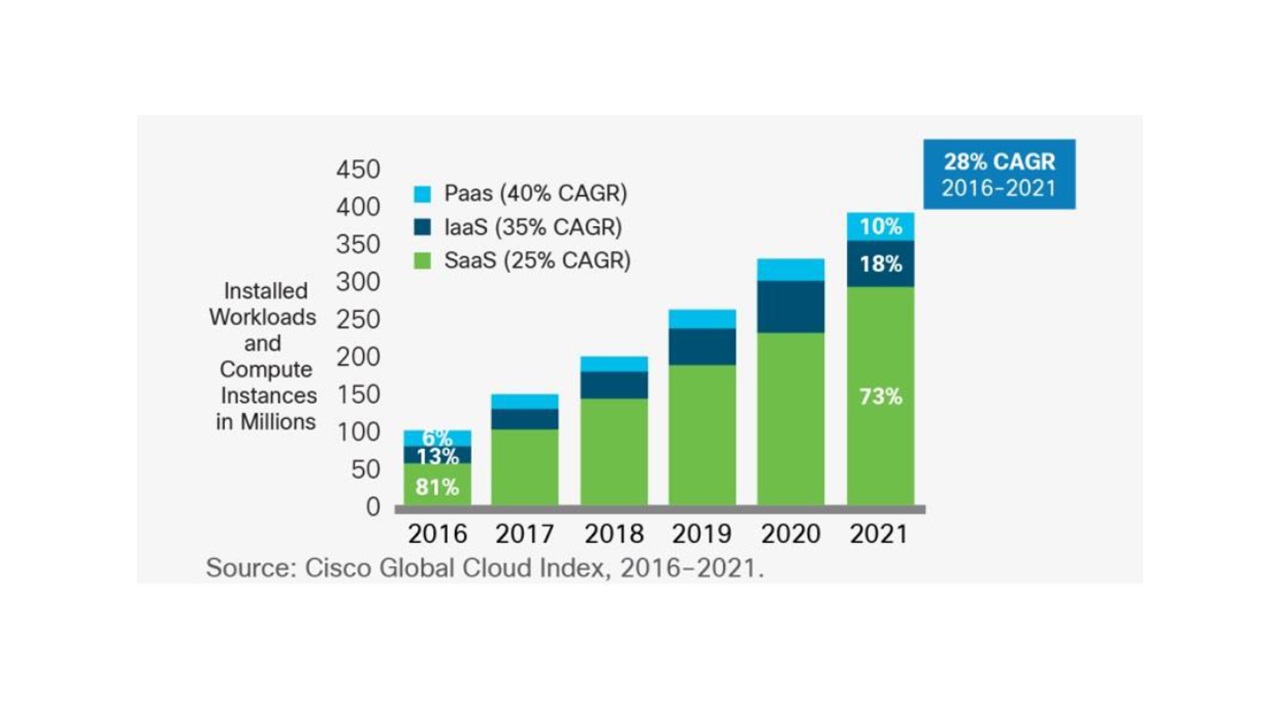It’s a Very Cloudy Forecast for 2021
Who can deny the impact of cloud computing over the past five years? Just during 2017 Amazon’s AWS revenue grew 45 percent, a very healthy rate for a 12-year-old business. AWS is not alone; Microsoft Azure revenue grew 98 percent year-over-year in 2017. Why should broadcasters and professional media types care?
The media industry has been digging in, leveraging the cloud’s growth, access, cost, agility and reliability across a wide range of workflows. At one end of the use spectrum is OTT streaming (think Netflix) that is 100 percent cloud dependent, and at the other end live HD event productions (e.g. sports, studio) that minimally use the cloud, public or private.
As access points and related bandwidth to the cloud increase, all media operations will have a cloud component; the advantages are too good to bypass. Is there a crystal ball handy to provide some insights into cloud evolution over the next few years?
The “Cisco Global Cloud Index 2016–2021” (published 1/2018) can help. The Index looks ahead to forecast the state of both the public and private cloud up to 2021.
CLOUD FUTURES—FOUR ASPECTS
Let’s consider four areas that have special bearing on media systems. First, is public cloud-projected utilization. According to the “Index,” “By 2021, 73 percent of cloud workloads and compute instances will be in public cloud data centers, up from 58 percent in 2016 (CAGR of 27.5 percent from 2016 to 2021).”
The remaining 27 percent is divided as 21 percent private and only 6 percent (and fading) traditional data center. Note, a private cloud is built using the design principles of public, although not to the same scale and usually operated by the enterprise that owns it.
Public has gained respect from media operators over the past several years. In my column ‘“Deadliest Catch’ Lands in the Cloud,” I reviewed the move to Amazon’s cloud by Discovery Networks for program ingest and playout of all their U.S. domestic channels.
This is proof positive that the cloud has been accepted by large, respected media enterprises for prime-time broadcasting. According to John Honeycutt, chief technology officer at Discovery, “Discovery’s business is more dynamic than ever. To distribute content on every screen and launch new and innovative products, the ability to scale our technical operation [in the cloud] is critical.”
A second area of interest is the ongoing move to software as a service (SaaS). When possible, don’t install and maintain software applications (e.g. scheduling, media asset management, creative tools, etc.). Rather, let the SaaS provider do the hard work of providing servers/apps, worldwide availability, scale and performance.
All SaaS apps can be accessed via browsers and allow for pay-as-you-go accounting and painless updates/upgrades. When shopping for new media applications, consider the SaaS model and eschew the installed model if possible. Apps that consume huge amounts of media data (e.g. some creative editing tools) are not SaaS-friendly in 2018. However, it’s easy to imagine nearly all media apps being cloud-centric in the future.
Fig. 1 indicates the SaaS public cloud delivery model will be 73 percent of all “cloud-installed workloads and compute instances” in 2021. Typically, each SaaS app delivery replaces, in some manner, an end-user-installed application (e.g. an EXE installed program on a PC or server). SaaS is making a big dent in how users install and access applications. For media-specific applications, many vendors offer browser-based apps either on-premise and/or cloud-based.

The third area of focus is security. From the “Index,” “Cloud workloads and compute instances are expected to nearly triple (grow 2.7-fold) from 2016 to 2021, whereas traditional data center workloads and compute instances are expected to see a global decline, at a negative 5 percent CAGR from 2016 to 2021.” Also, private cloud growth will be about 2.5x slower than public from 2016 to 2021.
A major reason for the growth of public over private/traditional is the increased confidence of users. Security was a huge obstacle to public cloud adoption just a few years ago. Today, savvy users appreciate the comment from research organization Gartner (2018), “Through 2022, at least 95 percent of cloud security failures will be the customer’s fault.”
Human error occurs whether using an in-house server or one from the cloud. Bottom line, security is a shared responsibility; part user, part cloud vendor.
The fourth area is cloud services adoption. Increasingly, enterprise systems have communications between an on-premise app/process and cloud processes using APIs. For example, say daily you need to modify an existing promo video (talk show) and update a section with new “appearing guest names.” Of course, a human editor can fire up an Avid or Adobe editor and get it done. With repetitive, templated tasks such as this, a software process could make the edit sans a human editor. How can this be done using the cloud?
There are two aspects to this. One is the client-side program (e.g. Python script) to orchestrate the edit, and the second part is the cloud-side process to do the edit. The cloud-side offers a service API that a simple Python program invokes to do the heavy lifting.
Imagine the sequence. A client-side program receives the “guest names.” It calls the cloud service API to insert the names into the promo video and out pops the new, edited file ready for broadcast.
As an example, consider the editing-services API from OpenShot. OpenShot provides a cloud service API enabling a variety of A/V edits (e.g. resizing, trimming, compositing, audio processing and much more). They offer a one-click launch of an Amazon AWS editing-services instance to kick things off. Try it and learn this facet of cloud services.
For another example see cloud.google.com/video-intelligence, with an API for indexing/searching video content. Media processing API’s are very cool.
FINAL WORDS
There is no stopping media apps and processes migrating to the public cloud. Look for ways to leverage the benefits. At the NAB Show/IBC, ask vendors what they are doing in this area to support the workflows you care about.
Finally, I have been writing Cloudspotter’s Journal for the past 6+ years, from inception. I have enjoyed researching and writing each article. However, it’s time to hang up my spurs as a columnist. Fortunately, longtime friend and fellow TV Technology columnist Karl Paulsen will take over the reins of Cloudspotter’s Journal. Thanks to editors Tom Butts and Terry Scutt for providing me with helpful guidance along the way.
Get the TV Tech Newsletter
The professional video industry's #1 source for news, trends and product and tech information. Sign up below.

